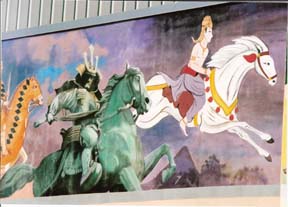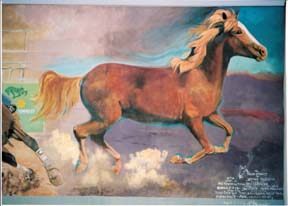 |
||||||||
| MEMO BLOG | Memo Calendar | Memo Pad | Business Memos | Loaves & Fishes | Letters | Home | ||
HEATHER HILL
THE MID-COUNTY MEMO
 |
| Portland Mural Defense advocates more freedom for artists to adorn neighborhoods with murals, like this recently completed mural by Larry Kangas at Parkrose High School Community Center. |
 |
| Parkrose High School’s new landmark piece of art may not stand alone much longer now that a court has ruled to allow the city to discriminate in favor of art. |
| MEMO PHOTOS: TIM CURRAN |
How would the community respond if a billboard of such a size were erected instead?
The city of Portland currently restricts billboard advertising to 200 feet. In 1986, the city exempted murals from this regulation. To underline the difference, the city defined a sign (in part) as something containing “text, numbers, registered trademarks and registered logos.”
In 1998, the city of Portland faced a lawsuit from Clear Channel Communications, a media and entertainment company that happens to own most of Portland’s billboards, saying that such content-based regulation of speech was unconstitutional. The court ruled in Clear Channel’s favor, and the city removed the exemption that November, effectively ending mural art in Portland.
For a number of years the city brainstormed on avenues around the wording. In 2004 the Regional Arts & Culture Council consulted with artists to create the Public Art Mural Program. This allowed for murals, such as PHS’s, to exist. However, it also imposed limitations. All murals were subject to approval by RACC, which was directed to judge only on artistic quality, originality, context, media, permanence, diversity, feasibility, scale and community support.
The public property contingent of the law requires private building owners to cede the specific space to the city in order to get a mural approved and funded. This process, however, may discourage some property owners from having a mural for privacy concerns, regardless of their consent to the art.
Another contention is funding. The current maximum a muralist can procure from RACC per project is $10,000. Considering the RACC budget, muralists argue that this amounts to a minuscule part of the pie.
Many cities have no such bureaucracy governing murals; they may also lack sign codes or pending lawsuits thereon. Last year Clear Channel again contested the mural exemption. This time around, the muralist community rallied for representation, nominating muralist Joe Cotter to intervene on its behalf. The muralists’ argument may have helped to shape the ultimate decision ordered by Judge Michael Marcus who, while upholding the ban on content-based discrimination, gave the city a right to prefer art over advertising.
Regarding the original 1998 opinion, Marcus wrote, “I can say with confidence that my conclusions in this litigation that the City cannot prefer murals over billboards (or other commercial advertising) were limited to the context of regulatory distinction based on the content of expression and were in no way intended to convey any suggestion that the City cannot prefer art through some other mechanism.”
To clarify, Marcus said, “Nothing I am aware of prevents the city from preferring art over commercial speech. Even in the context of regulation, the City may surely regulate distinct channels of communication based on what makes them distinct: as long as the basis for the distinction is not based on the content of any of these forms of expression.”
This decision (As of this writing, Clear Channel has indicated it plans to further litigate the issue by filing an appeal.) now enables new negotiations regarding all facets of mural art. On Jan. 7 the city announced the formation of a Murals Working Group to discuss regulatory alternatives afforded by the court’s new direction.
Coordinated by the mayor’s and City Commissioner Sam Adams’ offices, city attorney, Bureau of Development Services, Bureau of Planning, RACC and representatives of the muralist community, the Murals Working Group will work out new wording to segregate art from advertising to clearly enforce the current sign code while simultaneously expanding channels of artistic expression.
The January memo disseminated by the city loosely defined murals as “works of art for which no compensation or thing of value is given or received for the display or right to place the mural.” Billboards generate renewable revenue to display the sign, whereas a muralist gets paid once for the initial work alone.
On Jan. 15 members of Portland Mural Defense met to exchange views on how to best project their interests in conversations with the city. The group, organized by Joanne Oleksiak who spearheaded the PHS mural project, also included renowned Portland muralists Isaka Shamsud-Din, John Early, Mark Meltzer and Cotter, who led the proceedings. Shamsud-Din, Cotter and Oleksiak, with Meltzer as an alternate, will represent the muralist community in the upcoming workshop.
At the meeting, both veteran muralists and newbies voiced concerns with the new wording, specifically the compensation aspect. “I hope that we can make the really strong point that whatever you decide today is going to open up or limit the imagination of artists that haven’t been born yet,” Oleksiak said.
The muralists hope the city will concentrate on concrete distinctions to avoid the sticky and subjective necessity to define art itself. Even subtle differentiations pose difficulties. In the future, however the city draws the lines between signs and art, muralists hope to educate officials and others on murals’ intrinsic value to the neighborhoods they’re in, raising the estimation of the art in the public eye.
With more funding and freedom, professional artists have more incentive and resources to create higher quality artwork available outside the galleries of the Pearl District to illuminate neighborhoods in Mid-county and beyond.
Web Resources:
Portland Mural Defense: www.pmcalibrary.org
Regional Arts & Culture Council: www.racc.org
Commissioner Sam Adams:
www.commissionersam.org
 |
 |
 |
MEMO Advertising | MEMO Archives | MEMO Web Neighbors | MEMO Staff | Home